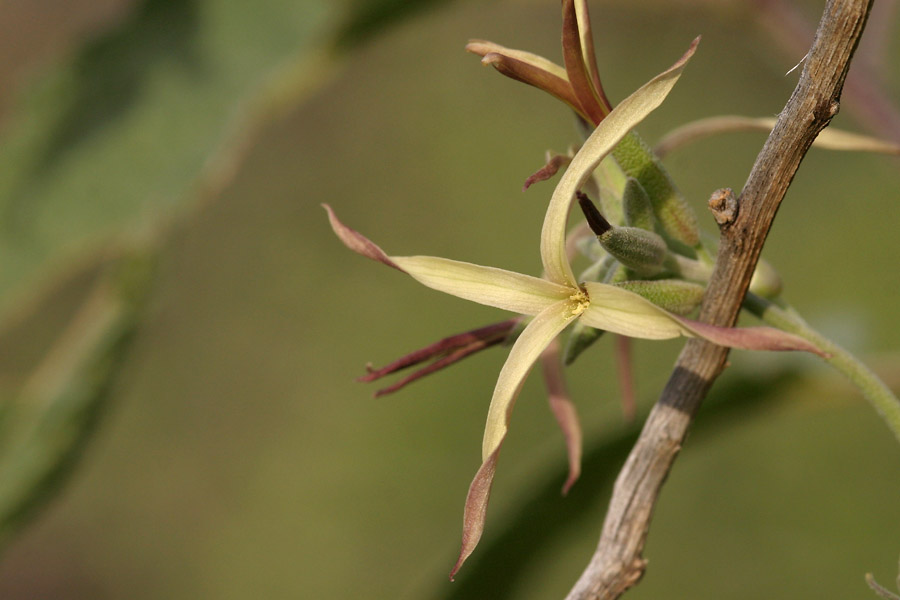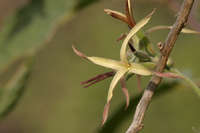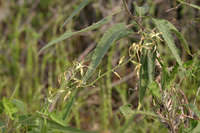Plants suffrutescent; moderately to densely pubescent throughout. Stems straw-colored, woody (at least proximally), many-branched, (2-)3-9(-11) dm. Cauline leaves: petiole 0.5-2.5(-4) cm (shorter distally); blades lanceolate, oblanceolate, or ovate in outline, (1-)2-9(-12) cm × (5-)10-50(-70) mm (smaller, less divided distally), base attenuate to cuneate, or truncate to hastate, margins usually pinnatisect to pinnatifid, or runcinate to dentate, rarely repand, teeth and lobes apiculate or not, sparsely to densely pubescent, nearly canescent. Fruiting pedicels divaricate to ascending or, rarely, reflexed, 2-7(-11) mm. Flowers: sepals (6-) 8-10(-11) × 1-1.5 mm; petals (twisted with age), (13-) 16-25 × 1-3 mm, claw 7-12 mm; filaments 4-6 mm; anthers 2.7-3.5 mm. Fruits (8-)10-25 × (8-)10-16 mm, base obtuse, apex deeply emarginate, (sinus to 8 mm deep), retuse, or truncate; style obsolete or to 0.5 mm. Seeds 2-3 mm diam. 2n = 36, 42.
Flowering late Sep-mid Apr. Gravelly or rocky slopes, desert washes, dry streambeds, sandy plains, shady ravines, granitic hills, mesa slopes, thorn scrub, stony ridges, gravelly arroyo beds, in open sun or under shrubs; 0-1300 m; Ariz., Calif.; nw Mexico (Baja California, Sonora).
Lyrocarpa coulteri, which is known from Pima and Yuma counties in Arizona and Imperial and San Diego counties in California, is extremely variable in nearly every aspect. The leaves range from relatively large, thin, and sparsely pubescent to smaller, thicker, and almost canescent; their shapes and margins are highly variable also. The flowers are strongly scented at night and appear to be moth-pollinated; their color varies a great deal. Fruit shape and size depend on the original number of ovules and how many of them mature into seeds, and one sometimes finds on the same plant fruits ranging from broadly obcordate to panduriform. Finally, the plants occupy a wide array of habitats; they can be tall, slender, and broad- and thin-leaved when grown in the shade of larger shrubs, whereas those growing in direct sunlight can be shorter, stout, and small- and thick-leaved.
With the above in mind, it is easy to understand why the two varieties recognized by R. C. Rollins (1941b, 1993) do not merit recognition. Variety apiculata was based on a fragmentary specimen with narrow petals and broad leaves apiculate at lobe apices and teeth. However, these two characters are uncorrelated. Similarly, var. palmeri was distinguished from var. coulteri by having broadly obcordate versus pandurifom fruits and 6-10 ovules, instead of 8-16 ovules, per ovary. As indicated above, fruit shape largely depends not on the number of ovules but on how many of them mature into seeds.
Duration: Perennial
Nativity: Native
Lifeform: Subshrub
General: Herbaceous to shrubby perennials, to 1 m tall or more, stems straw-colored, woody at least near the base, many-branched, usually erect and branching distally or weak and straggling and supported on other shrubs, herbage moderately to densely pubescent or canescent throughout, the hairs stellate, plants with a woody base and pungent, watery sap.
Leaves: Alternate, lyrate, lanceolate, oblanceolate, or ovate in outline, 1-12 cm long and 5-70 mm wide, becoming smaller and less divided distally, margins pinnatisect to pinnatifid or dentate to rucinate (with large, jagged teeth facing away from the blade tip), rarely wavy or sinuate (repand), teeth and lobes apiculate or not, bases attenuate to cuneate, or truncate to hastate, surfaces sparsely to densely pubescent or nearly canescent, petioles 0.5-4 cm long, becoming shorter distally, basal leaves not in a basal rosette.
Flowers: Light yellow, may also be brownish or greenish yellow to purplish, with 4 thin, linear to linear-oblanceolate and elongate petals forming a cross, petals twisting and sometimes with reddish undersides with age, 13-25 mm long and 1-3 mm wide, claw 7-12 mm, sepals 4, free, erect and linear to oblong-linear, 6-11 mm long and 1-1.5 mm wide, the lateral pair with a small sac basally (saccate), stamens 6 with 4 long and 2 short (tetradynamous), filaments 4-6 mm long, anthers linear and 2-3.5 mm long, ovary solitary and superior, generally 2-chambered with a septum connecting 2 parietal placentas, styles solitary, to 0.5 mm long, stigmas capitate, prominently 2-lobed, the lobes spreading, flowers borne in elongated racemes at branch tips.
Fruits: Sessile, heart-shaped (obcordiform or obcordate) to fiddle-shaped (panduriform or lyrate) or irregularly obovoid-triangular siliques 8-25 mm long and 8-16 mm wide, strongly flattened at a right-angle to the stem (angustiseptate) and not constricted betwee
Ecology: Found on gravelly or rocky soils on slopes, in desert washes, dry streambeds, sandy plains, shady ravines, granitic hills, mesa slopes, thorn scrub, stony ridges, and gravelly arroyo beds, in open sun or under other shrubs, from 0-4,500 ft (0-1372 m); flo
Distribution: Arizona, California; Mexico.
Ethnobotany: Unknown.
Synonyms: Lyrocarpa coulteri var. apiculata, Linnaeus coulteri var. coulteri, Linnaeus coulteri var. palmeri
Editor: LCrumbacher2012
Etymology: Lyrocarpa from the Greek lyra, "a lyre," and karpos, "fruit," referring to the fruit shape, and coulteri is after John Merle Coulter (1851-1928).








